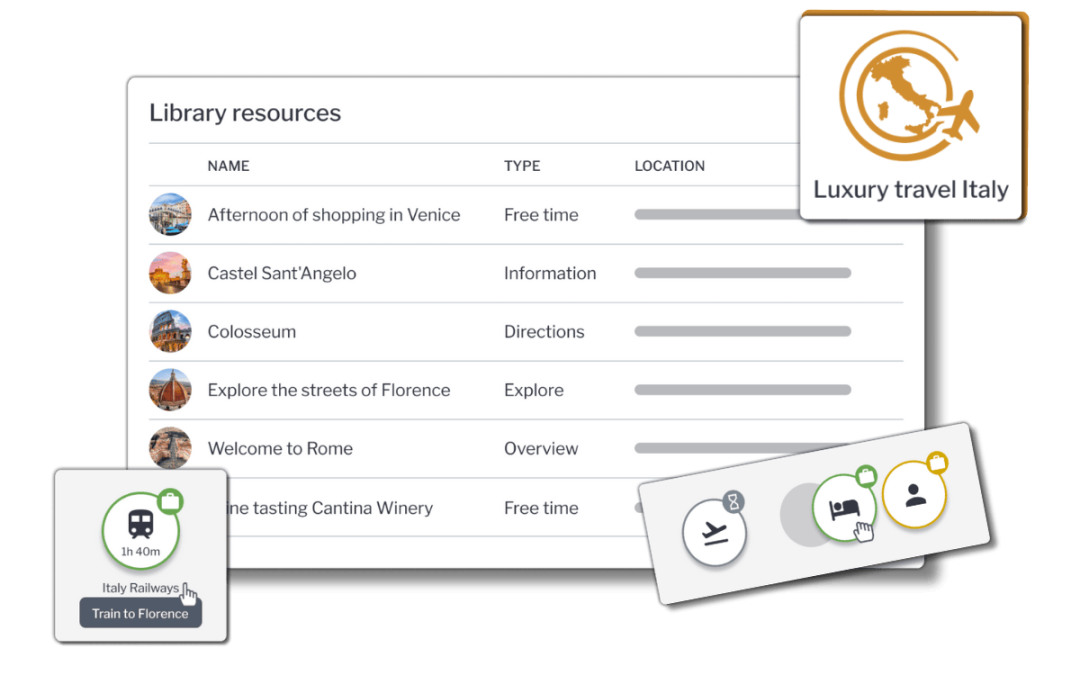The Hidden Cost of Double Entry in Travel Operations
It’s 11pm and you’re reviewing a quote one last time before sending it tomorrow. The itinerary is beautiful: a three-week journey through Scotland’s highlands and islands with private castle stays, whisky trail experiences, and a yacht charter through the Hebrides.
But you’re here cross-checking numbers, not admiring the trip.
You have the supplier rate sheet open in one tab. Your pricing spreadsheet in another. The draft quote in your CRM. Your itinerary in Canva. You’re verifying the numbers for the fourth time because something feels off.
The castle rate looks different from what you remember entering this morning. You check the email. Check the spreadsheet. Check the quote. They should match. They don’t.
This is the reality of disconnected systems or of using itinerary builders that are not connected to to your supplier rates database. And it’s not just inefficient. It’s a risk that negatively impacts your cost of sale.
What double entry actually means
In travel operations, double entry doesn’t mean accounting principles. It means touching the same data multiple times as it moves through your workflow.
Here’s the typical path:
- You build an itinerary in Canva or your itinerary builder
- Supplier sends you rates via email or PDF
- You enter those rates into your spreadsheet
- You pull those rates into a quote for your client
- You re-enter confirmed rates into your booking system
- You enter the same numbers again into your accounting software
The average luxury tour operator touches the same pricing data 7-10 times before a client sees their final quote. Some operators report entering the same piece of data in 30x. Each touch is a chance for something to shift.
The version control problem
When data lives in multiple places, which version is true?
You update a supplier rate in your spreadsheet. Your colleague builds a quote from yesterday’s version. The client confirms. You send the booking through with this week’s rates. Now you have three different numbers for the same room, and you need to work out which one you actually sold.
This isn’t a training problem. It’s a system design problem.
Most travel mistakes occur when you’re moving data from one platform to another. Planning multi-day itineraries is ridiculously complicated, and mistakes negatively impact your cost of sale. These aren’t catastrophic failures. They’re small discrepancies that compound. A rate that’s $20 off here. A supplement that didn’t transfer there. Over a complex itinerary, these add up.
Manual data entry carries an average error rate of 1% to 4%. In a bespoke itinerary with 50 data points (transfers, dietary requirements, flight times), a 4% error rate practically guarantees a mistake in every other booking.
How it compounds as you grow
When you’re small, double entry is manageable. Frustrating, but manageable. You know where everything lives. You can hold the details in your head.
Growth brings version conflicts. Two people update different spreadsheets. Someone uses last month’s pricing template. A new team member doesn’t know which CRM field to trust. What was annoying becomes dangerous to your margin and reputation.
Here’s a real example: A tour operator sent a quote for a 14-day Ireland journey. The pricing was based on a rate sheet from March. The supplier had updated their summer rates in April and the . The difference was €45 per night across eight nights. The quote went out €360 under cost before anyone caught it.
The client had already shared the quote with their travel companions. Changing the price meant explaining the error. The operator absorbed the difference to preserve the relationship.
Error correction costs an average of $450 per incident in staff time alone. That doesn’t count the margin you lose or the trust that shifts when numbers change between quote and confirmation.
The real cost isn’t time
Manual re-entry adds 2-3 hours per complex itinerary. That’s real. But the deeper cost is what happens when data can’t be trusted.
- Pricing becomes defensive. Uncertainty about your numbers forces you to add buffer. That buffer makes you less competitive. Or you skip the buffer and erode margin when errors surface.
- Client relationships suffer. Your clients expect precision. When a rate shifts between quote and confirmation, it reads as lack of control, regardless of whether it’s a supplier change or a data entry slip.
- Your best people burn out. Double entry isn’t just tedious. It’s tedious work where mistakes have real consequences. That combination drains your team. Nobody wants to spend their days hunting for discrepancies in spreadsheets.
- Growth becomes risky. You can’t confidently hand off pricing when the real answer might be in your head, or in Sarah’s spreadsheet, or in last week’s email thread. Knowledge that can’t transfer cleanly stops scaling in its tracks.
Sheenco Travel, a luxury operator now working across four countries, built their expansion on transparent cost management and complete markup control. An integrated system gave them pricing confidence as they grew from local operations to an international business.
Commercial safety as a foundation
Commercial safety means knowing your numbers are right. Not hoping. Knowing.
It means data entered once, used everywhere. Supplier rates in one place. When you build a quote, you’re pulling from that single source. When you confirm a booking, the same rates flow through. When you send to accounting, the numbers match what the client saw.
This isn’t aspiration. It’s operational foundation.
A single source of truth delivers:
- Automatic version control
- Updates that propagate everywhere they need to
- Teams working from the same information
- Delegation without anxiety about what might slip through
What changes when systems connect
When your itinerary builder and your supplier rates and quotes are all in one connected system, that 11pm verification ritual disappears.
You update a supplier rate once. That rate appears in every quote you build. Bookings and invoices automatically align. No hunting. No second-guessing.
The time savings matter. But the bigger shift is confidence. You build quotes faster. You bring on new team members without fear. You scale without the breaking points that come from fragmented tools.
Ahipara Luxury Travel moved from spreadsheets and Word documents to an integrated platform. They then took it one step further and integrated their accounting system, Xero, with travel management software, Tourwriter. Their finance team now link invoices with one click and has real-time visibility into costs. The shift gave them the flexibility to deliver truly bespoke luxury itineraries at scale.
When they connected their operations with Xero, the two-way sync eliminated reconciling different versions of the truth. Updates flow automatically in both directions. Every payment status stays accurate everywhere. No more double entry, no more manual reconciliation.
Where you are now
If this sounds familiar, you’re not alone. Most tour operators we work with started with spreadsheets and word docs or Canva. Some might have tried a exactly here. Spreadsheets and email and late-night verification sessions. It works until it doesn’t.
The shift to connected systems isn’t about chasing technology. It’s about building operations that support the business you want to become. Operations where your team works with pride, not stress. Where growth doesn’t mean more risk. Where you trust your numbers and get back to designing travel.
That 11pm moment doesn’t have to be your reality.
Ready to stop double-checking and start scaling?
See how Tourwriter’s integrated platform eliminates double entry and gives you a single source of truth from quote to invoice.
Book a demo to discover how luxury tour operators are building sustainable growth without the late nights.
What to explore next:
- Read how other luxury operators solved their double entry challenges
- Learn about automated financial reconciliation with certified Xero integration
- Discover how connected systems work in practice






